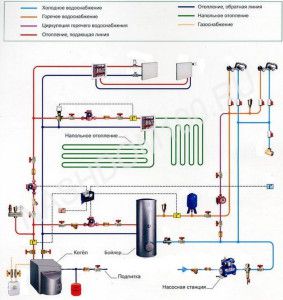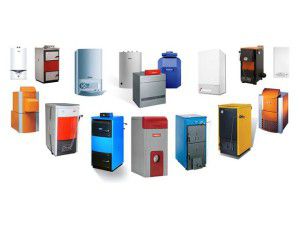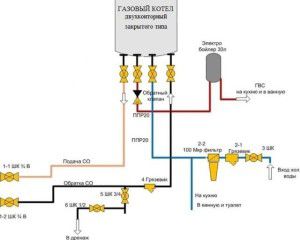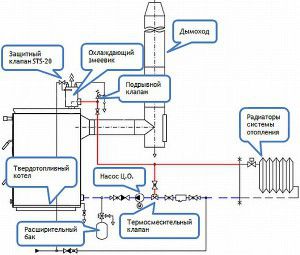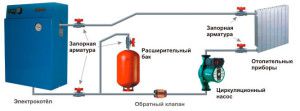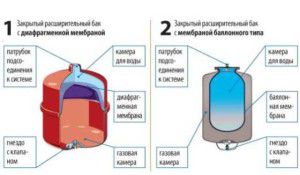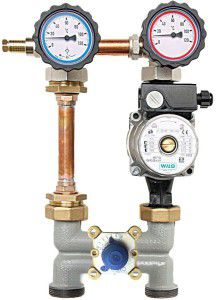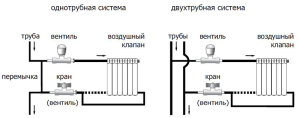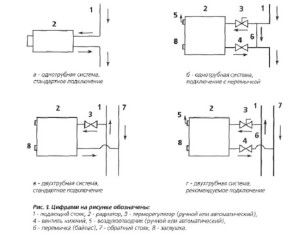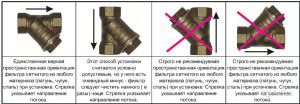What parameters should be given special attention when choosing components for heating? These include operational specifications that must be consistent with the design data of the system. However, in addition to this, a correct binding of the heating system is needed: boilers, pipes, radiators, pumps. She should be given special attention.
Purpose of heating equipment
Why is the heating boiler, radiator and pipe strapping scheme necessary? Its primary task is to ensure the correct operation of a specific heat supply element. Since the parameters of the system are not stable, their timely adjustment in a specific area is necessary.
Proper tying of the heating boiler with your own hands begins with the selection of its components and their adaptation according to the parameters of heat supply. They can be installed both in the immediate vicinity of the strapping object and remotely. It is important that their work does not affect the current quality of this element of the heating system.
Regardless of whether it is planned to tie a heating pump, radiator or boiler, a number of conditions must be met:
- Determination of the optimal circuit and its components. It depends on the purpose of the heater and its required functionality after starting the heating system;
- The degree of influence of the piping components on the radiator or boiler, the possibility of automatic or manual adjustment of their operation;
- Ensuring optimal operation of the entire heating system - limiting the flow of coolant in a particular section of the highway, mixing it with chilled water to reduce current energy costs;
- Work safety. It is for this that the piping of a double-circuit heating boiler is intended.
In addition, it is necessary to take into account the material of manufacture, the possibility of creating reliable fasteners and the compatibility of the components of the harness together. As a result, the developed scheme should ensure the normal operation of the entire heat supply system.
The binding of a floor heating boiler, radiators or pumps depends on the temperature regime of the system. All components must be designed for the maximum possible heating.
Complete set of boilers
In almost every video of the heating boiler piping, special attention is paid to the pipe layout and the general organization of heating. The required functionality of the boiler, as well as the safety of its operation, depends on these factors.
At the first stage, it is necessary to determine the model of the boiler, the type of fuel used and design. They will determine which piping of the diesel heating boiler will be optimal for a particular scheme. In addition, you need to consider the following parameters of heat supply:
- Type of system - one-pipe, two-pipe or collector. The method of connecting the boiler, as well as a list of additional components for its operation, depends on this;
- Equipment. Proper piping of a heating electric boiler may include a safety bypass and shutoff valves. If in the complete set of the device there is no circulation pump, expansion tank and safety group, these elements must be installed for water heating;
- Piping material. So, the correct binding of the heating boiler with polypropylene may differ depending on its design - solid fuel, gas or diesel.In some cases, the primary pipe is necessarily made of metal.
In practice, you can simplify the solution to this problem by reading the instructions from the manufacturer of the specific boiler model. It provides a complete list of materials, shows a piping diagram of an electric heating boiler or its solid fuel analog. But besides this, there are general recommendations for additional equipment for the heat supply of the house, depending on the type of boiler.
Before purchasing a boiler, you need to familiarize yourself not only with its functionality, but also with its configuration. She will determine the optimal circuit for heating the heater.
Tying gas boilers
This is the most common type of heating equipment for heating the coolant. There are many models that differ not only in appearance, but also in functional features and equipment.
To tie a double-circuit heating boiler, it is actually required to adapt it to the conditions of functioning of a certain heat supply scheme. If the device’s equipment already includes a safety group, a circulation pump, an expansion tank, additional installation of the following components will be required:
- Stop valves - mounted on all nozzles. It is best to use ball valves in the heating boiler piping scheme, since they can be used to quickly shut off the flow of heat carrier;
- Thermometers and manometers. If the boiler is not equipped with these measuring instruments, installation on the supply and return pipes is mandatory. If available, you can restrict yourself to tying the heating boiler yourself, by mounting the thermometer and manometer on the return pipe;
- Mixing unit. Needed to optimize coolant flow. If, according to the temperature sensors, the degree of cooling of the return flow is not high - it can be mixed with hot water.
When tying the heating boiler with polypropylene, do not install transitional corrugated hoses. This is a prerequisite for the installation of wall bypass models.
Some sources recommend the organization of a small auxiliary circuit for preheating water. After that, she supposedly should be served in the main. This should not be done, since a large temperature difference can lead to thermal shock, which will cause the failure of pipes, radiators and even the boiler.
For better DHW operation, the installation of an auxiliary storage tank is recommended. Its capacity can be from 50 to 200 liters.
Components for solid fuel and diesel boilers
For tying a diesel heating boiler or its solid-fuel analogue, one should take into account the high inertia of this type of equipment. Those. the rate of temperature change is much lower than that of gas models. This is especially true for solid fuel boilers.
Analyzing the video of the strapping of the heating boiler, we can conclude that special attention is paid to the security group. This is due to the above-described factor for adjusting the intensity of fuel combustion. Therefore, in addition to installing the elements necessary for tying the gas-fired floor heating boiler, the following components must be installed:
- Air vent. With its help, the accumulated air resulting from the overheating of the coolant is given;
- Drain valve. Each bundle of a floor heating boiler is equipped with it. It performs the same functions as the air vent, but for the coolant - water. As a result of overheating, its expansion occurs, which leads to an increase in pressure. To stabilize the system, it is necessary to forcefully remove a certain part of the liquid, and the bleed valve copes with this successfully.
In addition to these components, an expansion tank must be present in the boiler circuit of the boiler. Its design and installation location depends on the type of system - open or closed.
In open heating, the expansion tank is mounted at the highest point of the riser riser. In closed - before the supply of the cooled coolant to the boiler. In the latter case, it is necessary to correctly calculate the volume of the tank, and also observe the rules for its installation.
When tying a solid fuel heating boiler with polypropylene, steel pipes are first installed, and then polymer pipes are attached to them. This is necessary to prevent overheating of the polypropylene.
Tying electric heating boilers
The operation of electric boilers is built on a different principle than solid fuel or gas. Influence on water occurs due to heating of the heating element or indirectly. Regardless of this, all piping circuits of an electric heating boiler must have one component - a power connection block.
It includes an RCD, an uninterruptible power supply, as well as an automatic power regulator. All further equipment depends on the model of the boiler and its design. The easiest way to do the tying of the heating boiler with your own hands, if it already has automatic control devices, an expansion tank and a circulation pump. But this is not always found.
There is a special category of heating electrical equipment that do not have these components. These include electrode and induction models. In fact, they are only a heating element without additional control devices. In this case, the correct binding of electric heating boilers should be carried out according to the following rules:
- The size of the supply pipes is taken into account. The diameter of the pipes must match their cross-section. Otherwise, additional hydraulic resistance will arise;
- To control the temperature level, a thermometer must be mounted. The same applies to measuring the pressure indicator, for which a pressure gauge is needed;
- An additional filtration system for domestic hot water is provided in the piping of a double-circuit electric heating boiler.
In addition to these components, it is recommended to purchase a voltage stabilizer. Almost all types of alternative electric boilers are sensitive to voltage drops in the network.
It is only necessary to include a heating pump in the piping if the thermal expansion of the coolant cannot provide the proper level of circulation.
Features piping circulating pumps
A pump in the heating system is necessary for stable circulation of the coolant, which would not depend on the degree of expansion of water. It is installed according to the scheme at the point with the lowest water temperature - in front of its entrance for re-heating into the boiler.
The piping of the heating circulator is two parallel heating circuits. This is necessary to ensure unhindered movement of hot water during a power outage. If this is not done, resistance from a fixed impeller will worsen the already unsatisfactory indicators of natural circulation.
In practice, the following components must be included in the piping of the circulation pump of the heating system:
- Stop valves. With its help, the water flow is shut off to a certain section of the highway - main or auxiliary;
- Strainer. It is necessary to protect the impeller and rotor of the pump from the ingress of particles of rust or sediment from the surface of the pipes. It is a mandatory component in the piping of the heating system pump, is installed in front of it in the direction of the coolant;
- Check valve on auxiliary line. With natural circulation, a change in the direction of movement of hot water is possible. To prevent this, a check valve must be installed in the piping of the heating pump.
These are the main components of the circulation pump piping in heating systems. If you need to install an additional one, you should purchase a synchronizer for the stable operation of the pumps. It will synchronize the speed of rotation of the impellers, thereby minimizing the possibility of hydraulic shocks and periodic pressure changes in the heating system.
Before installing the pump in the piping of a diesel heating boiler, it is necessary to correctly calculate its power.
Binding radiators and batteries
Radiators in the heating system are needed to transfer thermal energy from hot water to indoor air. Therefore, special attention should be paid to their proper assembly and installation.
Possible options for tying heating radiators depend on the type of system. For the optimal configuration of a two-pipe scheme, you need to install the following components:
- Stop valves. Mounted on the inlet and outlet nozzles to shut off the flow of coolant in case of repair or replacement of the radiator;
- Temperature controller. It is installed on the supply pipe and is necessary to reduce (increase) the inflow of the volume of hot water to the battery. Tying heating radiators can do without it, but in this case it will be impossible to change the degree of heating of the surface;
- Mayevsky crane. Needed to remove air jams. It is installed in the upper pipe located on the back side of the incoming pipe.
Almost all of these components of the binding of radiators are implemented with the device. The exceptions are the temperature controller. It is best to buy it separately, based on functional requirements.
There are other options for strapping heating batteries for a single pipe system. The difference lies in installing a bypass - a connecting pipe between the supply and return pipes. It serves for unhindered passage of the heat carrier in case it is necessary to disconnect the radiator from the general system.
The bypass design must include ball valves to shut off the coolant. During normal operation of the system, their state remains closed. If in a particular embodiment of the heating radiator piping there is no temperature controller, then you can use the tap to change the volume of coolant inflow.
As an additional element, in addition to strapping the heating radiator, you can install a reflective film on the wall. Thus, it is possible to concentrate the thermal radiation towards the room.
General rules for piping
Proper piping of heating pipes consists in installing shut-off and control valves in certain areas of the system. But besides it, it is necessary to mount strainers in front of some devices - a circulation pump, an expansion tank.
To increase the period of non-repair operation of heating heating mains, additional components should also be installed. To a greater extent, this applies to polymeric materials of manufacture:
- Compensation loops. Necessary in the binding of heating pipes to compensate for thermal expansion;
- Contours. Designed for installation of intersecting pipes.
All other components of the piping relate to boilers, radiators and heating pumps. But what else do you need to know about the features of the configuration of heat supply components? It is important even before the moment of installation to choose the right accessories so that during installation you do not encounter the problem of their installation together with heating devices.
In the video material you can get acquainted with the features of the heating boiler piping:
